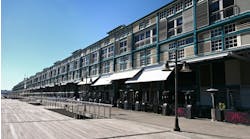The greenest building may be the one you already own, according to the National Trust for Historic Preservation.
A study of commercial and residential buildings in Portland, Phoenix, Chicago, and Atlanta revealed the potential for large carbon impact reduction by comparing the relative environmental impacts of building reuse and renovation vs. new construction over an assumed 75-year lifetime.
Contrary to popular belief, the benefits of reusing and renovating buildings outweighed the benefits of constructing new energy-efficient structures. According to the study, a new building that is 30% more efficient than the average building takes 10 to 80 years to overcome the negative climate change impacts resulting from construction.
The building reuse projects eked out carbon impact reductions that seemed small when considering only one building, but showed substantial savings when the whole city was under the microscope.
“If the city of Portland were to retrofit and reuse the homes and commercial office buildings that it is otherwise likely to demolish over the next 10 years, the potential impact reduction would total approximately 231,000 metric tons of CO2 – approximately 15% of their county’s total CO2 reduction targets over the next decade,” writes the Preservation Green Lab, a division of the National Trust.
Roughly 82 billion square feet of existing space will likely be demolished and replaced between 2005 and 2030, representing about 25% of the existing building stock in the U.S., projects the Brookings Institution. Reusing these buildings and renovating them for higher efficiency – especially with renovations requiring fewer material inputs – have the potential to realize the greatest short-term carbon savings, the study authors note.
“Most climate scientists agree that immediate-term action is crucial to staving off the worst impacts of climate change,” the researchers stress. “This study finds that building reuse can avoid unnecessary carbon outlays and help communities achieve their near-term carbon reduction goals.”


